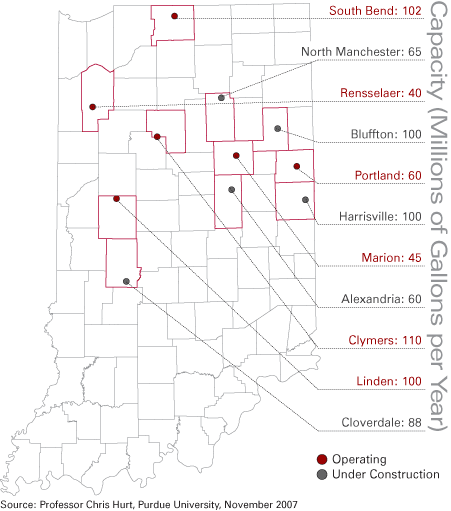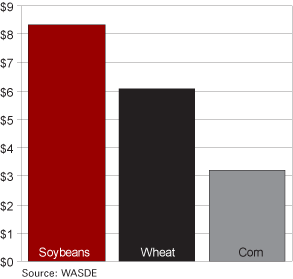Indiana Agriculture
Assistant Professor, Department of Agricultural Economics, Purdue University, West Lafayette
Indiana agriculture is going to enjoy the best financial times since the 1970s but will experience more uncertainty in 2008. The excitement of 2007—with the rapid growth of the biofuels sector, strong export demand, and record wheat prices due to very tight worldwide wheat supplies—is expected to continue in 2008. Going forward, the combination of growth in biofuels and strong export demand means high Indiana farm incomes and increasing farmland values.
Let's start by discussing the developments in the biofuels sector. As of October 2007, there are six operating ethanol plants in Indiana at Clymers, Linden, Marion, Portland, Rensselaer, and South Bend; these plants utilize about 169 million bushels of corn. There are an additional five plants under construction that will start operating in 2008 at Alexandria, Bluffton, Cloverdale, Harrisville, and North Manchester (see Figure 1). Once these plants are on line, ethanol production in Indiana will utilize 300 million bushels of corn (equivalent to 30 percent of Indiana's 2007 corn production—up from just 4 percent of corn production in 2005). This new usage for corn is happening throughout the Corn Belt and is dramatically altering Indiana's agriculture.
Figure 1
Ethanol Plant Locations and Plant Size, 2007

Indiana also has a growing biodiesel industry. The largest facility is the new Louis Dreyfus, Inc. soybean crushing facility at Claypool, which will process 50 million bushels of soybeans per year, equal to 25 percent of Indiana's 2007 soybean production.
While the biofuels sector has grown dramatically in 2007 and will continue to grow in 2008, future growth will slow considerably due to a reduction in ethanol margins. Over the last year, the price of ethanol has fallen from around $2.50 per gallon in January to $1.58 per gallon as of October 15, 2007. At the same time, the price of corn (the primary cost of producing ethanol) has remained above $3.50 per bushel. These falling ethanol prices and sustained corn prices are causing the ethanol industry to experience a sharp reduction in profit margins.
The biggest change in the ethanol industry is the decoupling of the price of ethanol from the price of crude oil. Even as the price of ethanol has declined almost $1 per gallon, the price of crude oil has increased from around $60 per barrel to over $90 per barrel. There are two reasons for this price decoupling: (1) the ethanol industry now produces enough ethanol to satisfy the oxygenate demand, and (2) the industry is facing capacity constraints in both blending and transportation infrastructure that will take a year or more to correct.
In addition to the biofuels sector, strong export demand and extremely tight worldwide wheat supplies are resulting in very high commodity prices. In the case of wheat, world stocks are the lowest since 1975–76 and U.S. wheat stocks are even tighter, at the lowest since 1948–49. As a result, the October 12, 2007, World Agricultural Supply and Demand Estimates (WASDE) projects that 2007–08 U.S. wheat prices will be around $6.10 (see Figure 2). These prices for wheat are well above the 1995–96 record of $4.55 per bushel. In the case of corn, exports are at their highest level in eighteen years. In addition, with all the new ethanol plants coming on line, the WASDE report projects that corn prices will be around $3.20 per bushel, higher than the 2007 price of $3.04. In the case of soybeans, with the sharp acreage reduction in 2007, supplies will be tight; the WASDE report projects that soybean prices will be around $8.35 in 2008, well above the 2007 price of $6.43. As a result of these high commodity prices, Purdue University estimates that Indiana net farm income will be around $2.2 billion in both 2007 and 2008, well above the 1997–2006 average of $1.2 billion. With these near-record farm incomes, the biggest challenge facing Indiana producers will be to manage increasing input costs.
Figure 2
Projected Prices for Soybeans, Wheat, and Corn, 2007–2008

Looking to 2008, the high commodity grain price, with its large impact on the returns to crop production, can be expected to increase the value of farmland. Farmland value also depends on factors including long-term interest rates, government price support payments, and real estate taxes. Given the current price levels for corn, soybeans, and wheat, prices continue to be well above the level where government price support payments would be triggered, reducing the influence of government programs. Long-term interest rates can be expected to increase, which would put downward pressure on land prices, but the rate increase is happening slowly. Overall, the biofuels and export boom increased the value of average quality Indiana farmland in 2007 by 17 percent and is expected to increase an additional 5 percent to 15 percent in 2008 according to the Purdue Land Value Survey. (1)
Note
- The Purdue Land Value Survey is available at www.agecon.purdue.edu/extension/pubs/paer/2007/august/paer0807.pdf.
Also in this Issue…
- Outlook for 2008
- The International Economy
- The U.S. Economy
- Financial Forecast
- Housing
- Indiana Agriculture
- Indiana
- Anderson
- Bloomington
- Columbus
- Evansville
- Fort Wayne
- Gary
- Indianapolis-Carmel
- Kokomo
- Louisville
- Muncie
- Richmond
- South Bend-Mishawaka and Elkhart-Goshen
- Terre Haute
- Return to Table of Contents



